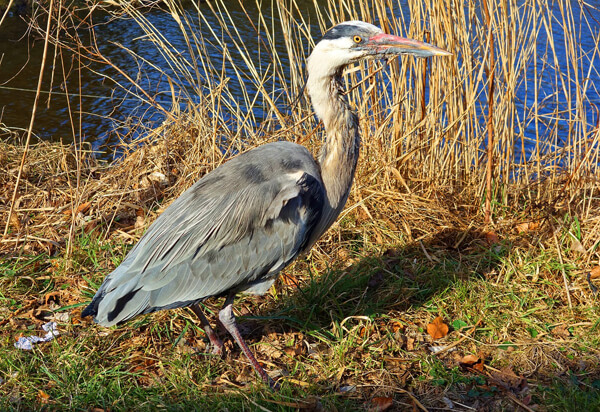Heron are notorious for searching out fish ponds for easy pickings during the nesting season. Not only do they have the determination to deplete an entire fish stock from a pond but there is also the potential risk of them damaging the pond liner.
Observing these birds habits and actions has helped to find ways of preventing them from feeding on the fish in garden ponds. Heron are tall (90-100cm), with a long neck, long legs to allow them to wade in water and a dagger-like beak evolved for snapping up fish. When in search of food it stands completely motionless in the water, waiting for a fish to swim close enough for it to swiftly seize it.
The grey heron wades into water and fishes in the water from a standing position. There are various products available from aquatic stockists or you can make your own ‘Heron proofing’.
- Netting – Persuading herons not to raid fish ponds is very difficult. Netting is considered by many fish pond owners to be the only effective protection. The downside, however is that marginal plants are likely to get caught-up in the netting. A sheet of black mesh pulled taut above the water is also a good option because plants can grow through. Mesh secured at a height of about 30cm above the water will still allow small birds to access the pond from the edges.
- Stakes – If netting detracts from the beauty of your pond or gets in the way when cutting back plants etc, then another option is to dig wooden posts into the ground around the periphery. Attach a length of rope to each of the posts to stop herons wading into your pond. This method has been tested by pond owners with positive outcomes.
- Suspended line – Less glamorous than rope but also less intrusive is the use of fishing gut attached to and held in place by cane, plastic or metal supports at a height 15 to 30cm’s above the ground. This will disturb herons when they walk towards the pond where there isn’t ample shallow beached areas to allow them to land straight into the water.
- Shelter – Floating plants such as the waterlily offer shelter from predators as do overhanging boulders.
- Vertical sided ponds – Herons prefer to fish in shallow water, so vertically sided ponds with depths of 1.2 meters or more are less attractive. Fish in steep-sided ponds are therefore less likely to get frightened off unless one at the surface is stabbed by a heron swooping over the pond.
- Dog – Pets left to run around freely in the garden can make it a less attractive place for heron to visit.

While these protective measures offer some resistance to unwanted heron visits, pond fish are only really safe when they hide at the bottom depths of a pond.
Herons are a protected species so for that reason plus the fact that past winters have been relatively mild has resulted in an increase in heron numbers in the UK. You are likely to see them roosting in rural treetops particularly near rivers and canals. They can, however travel great distances in search of food so visits to urban ponds are not uncommon. An adult heron needs up to half a kilogram of food per day, so can be extremely persistent and determined in their hunt for food which is why fully protecting a fish pond can be such a huge challenge. In spring and early winter fish are sluggish coming out of or going into a period of dormancy, so become easy targets. This really is a time you need to be most vigilant against these unwanted visitors.





